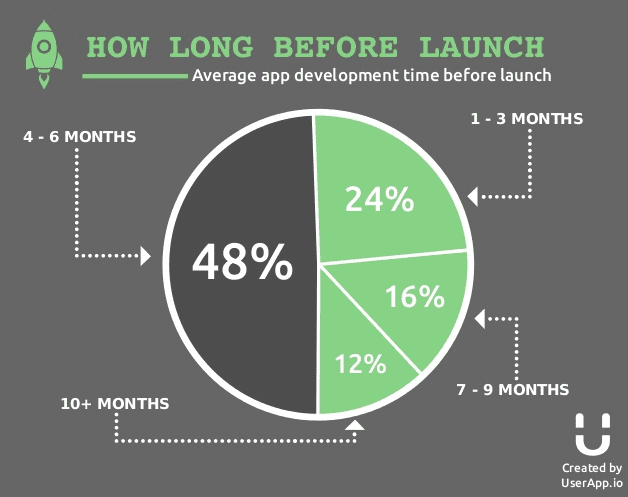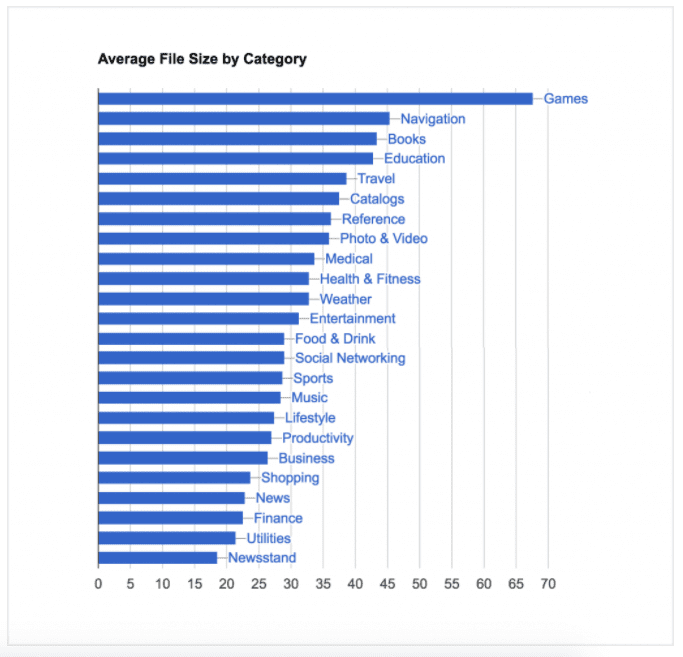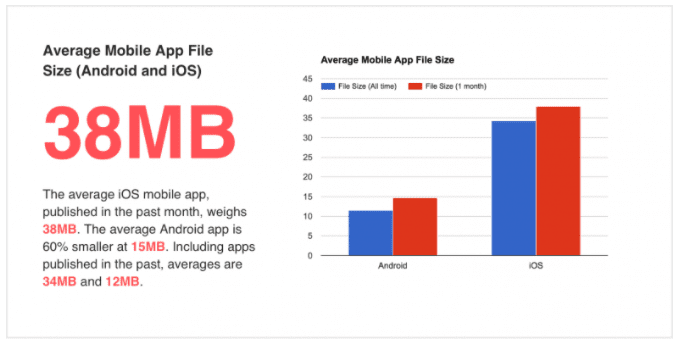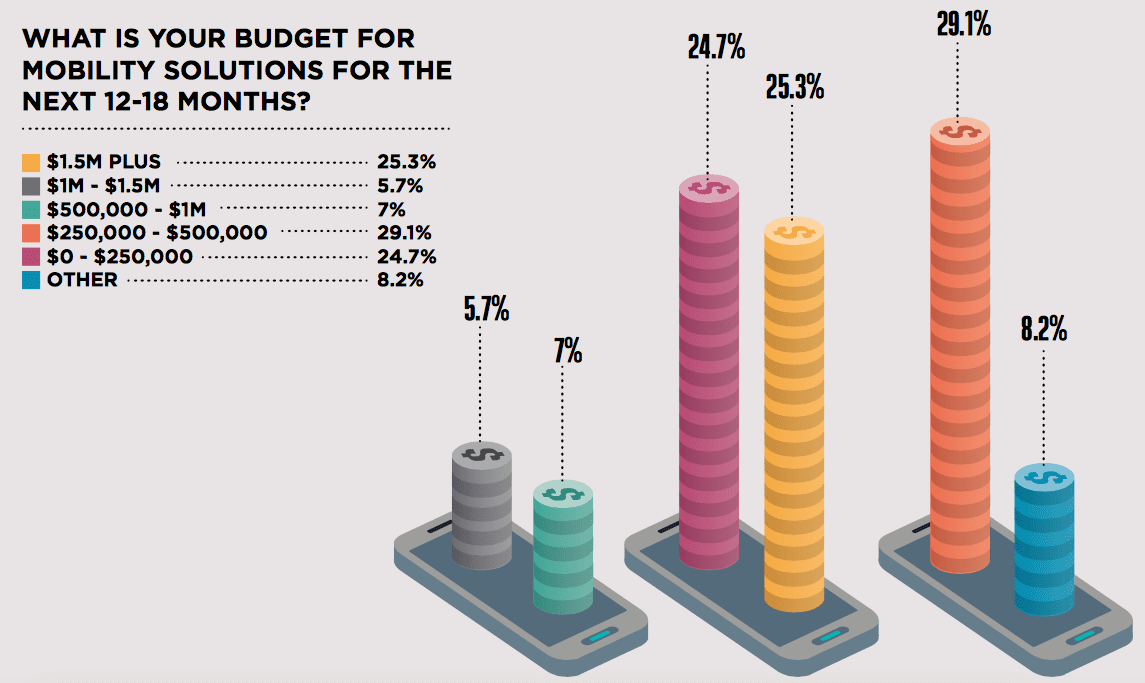Time is money.
The longer an app takes to build, the more it will cost.
If you’ve started pricing out different options for development, you’re probably starting to realize that this process isn’t cheap.
There’s no one size fits all answer for an app development timeline.
Every app is unique, and there are lots of different factors that will impact how long it takes.
We’ll go into more detail about those elements shortly.
For the most part, it will take roughly six months to develop an app.
If you’re lucky, and I mean very lucky, it could be done in about four months.
I’ve seen it done.
But I’ve also seen apps take 12 or even 18 months to build.
It depends on what you’re trying to accomplish.
You’ve got to weigh your options.
On the one hand, you want the app to get built fast. That will keep costs down and get your app to market faster so you can ultimately start making money.
After all, that’s the whole point of this, right?
But if you rush through the development process, it could end up costing you more money in the long run.
You don’t want to cut corners.
However, being too much of a perfectionist can stretch the development stages too long, which can bleed your pockets dry.
That’s definitely not something you want either.
So it’s important to find a middle ground between those two ends of the spectrum.
A word of warning – while you’re mileage may vary, there are always ways that you can gauge how long it will take to build your app before it launches.

I’ll go over the factors that impact your development timeline.
As an industry expert who has lots of experience building apps, I’ve narrowed down the most important elements that you need to consider to plan a realistic timetable.
After you read through this guide, you’ll have a much better idea of how long it will take to build your app.
Quality
You’ve got to make sure that the quality of your app doesn’t suffer based on your timeline.
That’s why it’s super important that you start with a realistic goal.
Don’t start over promising something and end up under delivering on that promise.
The quality will suffer.
Here’s what I mean.
Let’s say you have a business and you’re planning to launch an app to enhance the customer experience and generate new revenue streams.
But if you’re starting the mobile app development on January 1st, don’t start telling your customers that it will be available for download by March 1st.
That’s a big mistake.
Quality takes time.
Good apps take time.
That’s the reality of this situation. However, what constitutes “good” is often on a sliding scale.
If you’re going to try and pump an app out in a couple of months, the quality will suffer.
With that said, there are certain scenarios where it’s reasonable to have a development period that can be greatly accelerated.
This is much more reasonable if you’re just trying to create a proof of concept or a minimum viable product (MVP).

In this case, you can definitely expect to have a shorter development timeline.
It’s also reasonable to expect a shorter timeline if your is simple.
I’m referring to basic apps that don’t need complex coding and in-depth features.
On the flip side, if you’re trying to develop an app that’s super complicated, you can expect it to take a while longer.
But I’ll go into greater detail on the functionality of your app a little later.
For now, let’s get back to quality.
With simple apps and MVPs, the quality generally won’t suffer by accelerating the development period.
That’s just because there’s not a whole lot to it.
Here’s a reasonable analogy to illustrate my point.
Imagine that you’re building a house.
It doesn’t have to be a mansion, but it’s going to be average size with a few bedrooms and bathrooms.
Building it won’t happen overnight.
I mean you can try, but the quality will obviously suffer.
But now let’s say you want to build a small shed or a dog house in your yard.
The shed (MVP) can definitely be built in one day and still be a quality product.
So think of your app development the same way.
Who develops your app will also impact the quality.
I’ll talk about the developer options later on and how that relates to your timeline as well.
Size Matters
As we just saw with the house analogy, the size of your project will impact the length of development.
Here’s a look at the average file size for different apps based on their category on the iOS platform.

For the most part, the app categories toward the top of this chart are more complex.
So as a result, they will take longer to build.
Take a look at the categories at the bottom of this chart, like utilities, for example.
What’s a utility on your phone that you might use?
A calculator?
Well, something that like that is really simple to develop so the size isn’t very large.
There are four main factors that impact the size of your app and contribute to the length of development.
- Scope
- Depth
- Features
- Purpose
Here’s what you need to know about each one of these elements.
Scope
The scope of your app refers to its outreach.
So for example, is your app for small neighborhood school PTA?
Or is it intended for a multinational corporation that has to link to hundreds of backend APIs?
You can see how the difference between these two examples would impact the size.
Furthermore, the scope also has to do with the screen sizes that need to be supported and the platforms targeted.
So if your app is going to be launched on the Google Play Store, it will need to support the screen sizes for all of the various Android phones and tablets.
With that said, addressing the screen size during development isn’t too complicated.
A much harder decision is focusing on the platform.
Which should you develop for first? Android or iOS?
While that may be a conversation for another day, your answer will affect the size.

Based on this data, you can clearly see that iOS apps are significantly larger than Android apps.
So that’s something else that you can keep in mind when you’re trying to determine the scope of your development.
Depth
The depth of your app has to do with the user accessibility.
Do you want users to access it only when it’s necessary?
Or will they constantly need interactivity and new features?
So if the app will only be used infrequently and for the same basic purpose each time the user opens it up, the development won’t take as long.
But if you’re trying to build something that needs constant user interaction to deliver the best experience, you can expect to pay more and have a longer wait until you can launch it.
Features
The features typically piggyback off of the depth.
Development time is directly connected to the complexity of your features.
If your app is going to use common plugins, it will be easier for a developer to install them and it take less time.
But this process will take much longer for those of you that need completely customized features built.
The user experience will impact the features as well.
Here’s what I mean.
Does every user see the same interface when they access your app?
Apps that require unique user profiles and customized logins have more in-depth features.
Typically, those apps also have other complex features like updates in real time.
Let’s look at an example of an app built for finding taxis in the UAE, with functions similar to Uber.

Think about how many features need to be developed for something so complex like this.
They’ve got to connect drivers with riders using real time GPS tracking.
Every user needs to have their own unique profile.
This app also requires a secure way to store and process payment information.
And these are all just the basics.
There’s so much more that goes into building an app with features like this.
The depth will also require constant updates.
In short, if you’re trying to develop something with similar features it’s going to fall on the later end of the average timeline.
Purpose of the app
All apps start as an idea.
But you’ve got to make sure that idea translates into a clear purpose of your app.
Who is it benefiting?
Why would someone use this?
How is this app making life faster or easier for the user?
If your answers are all over the place, it’s going to be difficult to find a clear purpose.
Looking back at the example we just discussed about the UAE taxi app.
Trying to add features that make the app double as a social media platform is unnecessary and conflicts with the clear purpose.
Or say you’re building an app that provides users with up to date sports scores. You wouldn’t need to add features like GPS or games.
That just complicates things, and it has nothing to do with the clear purpose.
If your purpose isn’t well defined before you start development, you’ll turn what was one a simple app into something that’s a bloated monstrosity.
Not only will it take you forever to develop, but it will also become a sinkhole for your money.
So stick to just one idea and run with it.
Dolla dolla bills y’all
As I’ve been hinting at this entire time, the longer your development takes, the more money it’s going to cost you.
This isn’t always a bad thing.
Like we’ve also seen, sometimes it’s necessary to spend more money based on how complex your features are.
Money talks.
You’ve got to start with a budget.

Your budget needs to be reasonable and realistic.
Don’t try and build the next Snapchat or Instagram with a $10,000 budget.
Do the research and get an appropriate idea of how much each phase of your development will cost you.
The last thing you want to happen is to get through 70% of development and run out of money.
Believe it or not, I’ve seen it happen many times.
This is not a situation that you want to find yourself in.
Now you’ve got a half finished product that’s absolutely useless and no way to get your money back.
But here’s something else I want to stress to make myself clear.
More money is not always the solution to development.
While your budget needs to be reasonable, having a budget that’s too high won’t always help you out either.
Then you may feel the need to spend it on unnecessary things like adding more developers or throwing money at features you don’t need.
This will just end up causing more problems than solutions.
There is a lot to be said about fighting through adversity.
A focused approach with an accurate budget can save you money as well as time in the long run.
Who builds it
The person or people who build your app is a critical factor in terms of your timeline.
You can find a freelance developer, small development shop, or large development agency if you want to outsource it.
Or you could build it yourself.
Sure, you could build an app on your own and probably for not too much money.
But you get what you pay for.
Even if you’re saving some money, you won’t be saving much time.
How long do you think it will take you to learn how to code, develop, test, correct, redevelop, and publish your app?
I’ll give you a hint – it’s a long time.
Professional development teams get the job done.
Just make sure that if you go through a third party to build your app that they will partner with you.
You want these people to understand your business.
That way they can develop an app that truly meets your goals and stays aligned with your strategy.
Working with a professional developer who can act as a strategic partner will greatly benefit your final product.

In my experience, I’ve found that it’s easier to accomplish this type of relationship if you’re working with smaller app development agencies.
You just need to find a developer that feels right for you and can put forth their best effort.
Don’t think of it as extra spending. Instead, think of it as investing.
But working with a developer that’s too small isn’t always the best solution either.
If they have too many clients, they won’t be efficiently able to manage their time.
That means that your development timeline will go on much longer than it needs to.
Managing expectations (conclusion)
The bottom line is this – good apps take time.
That’s the reality.
Time is money.
You’ve got to recognize that the longer your app takes to develop, the more it’s going to cost you.
There are lots of factors that can help you determine a realistic development timeline for your unique situation.
Quality and size are two of the biggest elements that impact the time.
You’ve got to budget yourself accordingly so you can afford the features that are related to the basic purpose of your app.
Who builds your app will also play a major role in your launch timeline.
Knowing what you want, what you’re getting into, and how you plan to get there will help make this process go faster and more efficiently.
Hopefully, this article has enlightened you with the realistic issues regarding app development timelines.
If you have any questions about development, the BuildFire Pro Services team has answers.
What unique features of your app do you think will take the longest amount of time to develop?